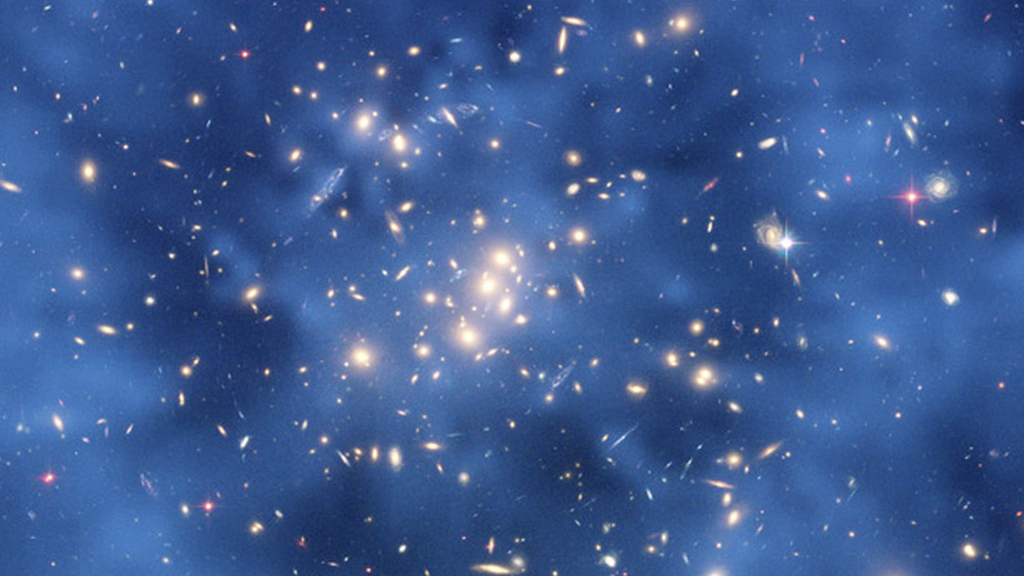A dark matter of fact? The hunt for elusive particles
It has been described as “trying to pin down a shadow”, and yet scientists are hopeful that they may have found evidence in the hunt for dark matter. So what have they discovered?

If you have a conversation with a particle physicist about dark matter, three words you are likely to hear a lot are “we don’t know”.
Knowledge of dark matter is limited. What scientists do know, so they says, is that it does not reflect or emit light – making it incredibly difficult to find.
It is one of the things that will determine the future of the universe – Dr Alan Barr
It is also believed to be the “dominant form of matter in the universe” – making up around 25 per cent of the universe – compared to the “normal” matter, occupying around 5 per cent of the unvierse, such as that which makes up planets, stars and galaxies.
What they don’t know is what its properties are, and crucially, how to find or make it.
If they found out, it could unlock the key to how the universe is held together, and may even provide us with an energy source for the future.
“Dark matter hides our ignorance in a way”, Dr Alan Barr, lecturer in particle physics at Oxford University and UK physics coordinator for the Large Hadron Collider’s ATLAS team, told Channel 4 News.
It is, he said, something that is known to exist because of the gravitational effect it has on other objects. “It has been the thing that is responsible for forming galaxies,” he said. “It is one of the things that will determine the future of the universe.”
Pinning down a shadow
On Wednesday, scientists from the CERN-run Alpha Magnetic Spectrometer (AMS) experiment, presented their first set of evidence. The AMS is a particle physics detector which is attached to the outside of the International Space Station, in conjunction with NASA.
The evidence supports the existence of dark matter – Dr Samuel Ting
The AMS is searching for dark matter by analysing cosmic rays – high-energy charged particles that permeate space. Amongst these particles, AMS has found positrons, also known as anti-electrons, a form of antimatter (see antimatter/dark matter explainer below).
It’s thought that one of the ways that positrons are created is through the collision and subsequent “annihilation” of dark matter particles in space. Another theory is that they are emitted from pulsars – highly magnetised neutron stars.
Over 18 months, the AMS recorded 400,000 positrons with energies of between 0.5 and 350 giga electron volts (GeV).
These positrons have led to two observations that support the theory of dark matter positron creation.
Antimatter and dark matter
Antimatter is matter with its electric charge reversed. A positron, for example, is the opposite of an electron as an electron has a negative charge and a positron has a positive charge. It exists but it is believed there is not much of it in the universe. Scientists have theorised that the Big Bang produced equal amounts of matter and antimatter, but that then the majority of the antimatter mysteriously disappeared. It can be created naturally, as theorised in relation to dark matter or pulsars, or on Earth via colliders.
Dark matter is believed to exist because it explains the reason for gravitational discrepancies, such as the orbital velocity of large clusters of galaxies in space. It is believed to make up around 25 per cent of the universe, and in total around 80 per cent of all mass within the universe.
Firstly, the AMS team said that there was an “excess of positrons in the cosmic ray flux” – something they said is consistent with dark matter particle annihilation.
Secondly, there were no particular directions from which the positrons were coming – which could have suggested the particles were being emitted from pulsars.
Dr Samuel Ting, who presented the results, said: “The evidence supports the existence of dark matter, but we cannot rule out that they possibly came from pulsars. But I am confident that in time we will be able to solve this problem.”
It appears to be the dominant form of energy that might be available to us – Dr Alan Barr
However, there was no news today on the behaviour of positron particles at the higher energy levels, above 350 GeV. According to Dr Barr, it is this evidence that could provide us with a clearer insight into the existence of dark matter.
He told Channel 4 News that if positrons are coming from dark matter particle collisions, then there will be a steep drop off in the amount of energy the positrons are carrying.
This is because the dark matter particles will have a specific mass – and therefore, “there will be a ceiling an upper limit on energy levels” of the positrons produced by their collisions.

Why does this matter?
Proving the existence of dark matter will not only be a breakthrough in understanding how galaxies exist, and what the future for the universe might be.
Theories about dark matter also suggest that its existence implies other dimensions within space – confirming the existence of dark matter could be a way of discovering whether or not theories of extra-dimensional space are true.
But there are, potentially, practical applications. Because dark matter particles are “heavy”, the amount of energy they produce when they collide could be “the biggest source of energy in the universe”.
Dr Barr said: “It appears to be the dominant form of energy that might be available to us. It is not impossible that we would find a way to harness that.”
As well as sifting for evidence on the International Space Station, the Large Hadron Collider in Cern is looking for, and potentially trying to create, dark matter. Dr Barr said that with more evidence from AMS, that hunt will get easier.
“If there was a signature then that would tell us where we should be looking”, he said.
And with the collider getting an upgrade for 2015, meaning collisions being achieved at higher energy levels, there is hope that the universe’s most elusive particles may yet be found.
-
Latest news
-
Why Rishi Sunak really went for snap general election31m

-
Post Office scandal: workers react to ex-CEO Vennells at inquiry4m

-
Election 2024: what voters think of Rishi Sunak announcement3m

-
Post Office inquiry: former boss Vennells admits evidence was false5m

-
‘We are going after every vote we possibly can’, says deputy leader of Liberal Democrats4m

-




